Kit Carson
| Kit Carson | |
|---|---|
 Kit Carson, circa 1860 | |
| Born |
December 24, 1809 Richmond, Kentucky |
| Died |
May 23, 1868 (aged 58) Fort Lyon, Colorado |
| Resting place |
Kit Carson Cemetery Taos, New Mexico |
| Residence | Taos, New Mexico |
| Nationality | American |
| Occupation | Mountain man, frontiersman, guide, Indian agent, United States Army officer |
| Known for | Opening the American West to European settlement |
| Spouse(s) |
|
|
Military career | |
| Allegiance |
Union |
| Service/branch | Union Army |
| Rank | Brevet Brigadier General |
| Commands held | 1st New Mexico Volunteer Cavalry Regiment |
| Battles/wars | |
| Signature | |
|
| |
Christopher Houston "Kit" Carson (December 24, 1809 – May 23, 1868) was an American frontiersman. The few paying jobs he had during his lifetime included mountain man (fur trapper), wilderness guide, Indian agent, and American Army officer. Carson became a frontier legend in his own lifetime via biographies and news articles. Exaggerated versions of his exploits were the subject of dime novels.
Carson left home in rural present-day Missouri at age 16 to become a mountain man and trapper in the West. In the 1830s, he accompanied Ewing Young on an expedition to Mexican California and joined fur trapping expeditions into the Rocky Mountains. He lived among and married into the Arapaho and Cheyenne tribes.
In the 1840s, he was hired as a guide by John C. Fremont. Fremont's expedition covered much of California, Oregon, and the Great Basin area. Fremont mapped and wrote reports and commentaries on the Oregon Trail to assist and encourage westward-bound American pioneers. Carson achieved national fame through Fremont's accounts of his expeditions.
Under Fremont's command, Carson participated in the uprising against Mexican rule in California at the beginning of the Mexican-American War. Later in the war, Carson was a scout and courier, celebrated for his rescue mission after the Battle of San Pasqual and for his coast-to-coast journey from California to Washington, DC to deliver news of the conflict in California to the U.S. government. In the 1850s, he was appointed as the Indian agent to the Ute Indians and the Jicarilla Apaches.
During the American Civil War, Carson led a regiment of mostly Hispanic volunteers from New Mexico on the side of the Union at the Battle of Valverde in 1862. When the Confederate threat to New Mexico was eliminated, Carson led forces to suppress the Navajo, Mescalero Apache, and the Kiowa and Comanche Indians.
Carson was breveted a Brigadier General, and took command of Fort Garland, Colorado. He was there only briefly: poor health forced him to retire from military life. Carson was married three times and had ten children. The Carson home was in Taos, New Mexico. Carson died at Fort Lyon, Colorado, of an aortic aneurysm on May 23, 1868. He is buried in Taos, New Mexico, next to his third wife Josefa Jaramillo.
Early life (1809–1829)
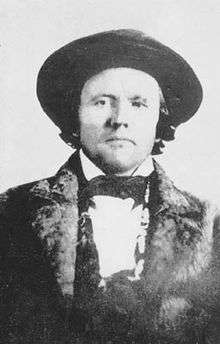
Carson was born in Kentucky on Christmas Eve, 1809. His parents were Lindsay (or Lindsey) Carson and his second wife, Rebecca Robinson. Lindsay had had five children by his first wife Lucy Bradley, and ten more children by Rebecca. Kit was their sixth, making him the eleventh of Lindsay's offspring.[1][2]
Lindsay Carson had a Scots-Irish Presbyterian background.[3] He was a farmer, a cabin builder, and a veteran of the American Revolutionary War and the War of 1812.[1] He fought Indians on the American frontier, losing two fingers on his left hand in a battle with the Fox and Sauk Indians.[3]
The Carson family moved to Boone's Lick, Howard County, Missouri when Kit was about one year old. The family settled on a tract of land owned by the sons of Daniel Boone, who had purchased the land from the Spanish. The Boone and Carson families became good friends, working and socializing together, and intermarrying. Lindsay's oldest son William married Boone's grand-niece, Millie Boone, in 1810. Their daughter Adaline became Kit's favorite playmate.[4]
Missouri was then the frontier of American expansionism west; cabins were "forted" with tall stockade fences to defend against Indian attacks. As men worked in the fields, sentries were posted with weapons, to protect the farmers. These men were ready to kill any Indian who attacked.[1][3] Carson wrote in his Memoirs: "For two or three years after our arrival, we had to remain forted and it was necessary to have men stationed at the extremities of the fields for the protection of those that were laboring."[1]
In 1818 Lindsay Carson died instantly when a tree limb fell on him while clearing a field. Kit was about 8 years old. Despite being penniless, his mother took care of her children alone for four years. She then married Joseph Martin, a widower with several children.[5] Kit was a young teenager at the time and did not get along with his stepfather. The decision was made to apprentice him to David Workman, a saddler in Franklin, Missouri. Kit wrote in his Memoirs that Workman was "a good man, and I often recall the kind treatment I received."[6]
Franklin was situated at the eastern end of the Santa Fe Trail, which had opened two years earlier. Many of the customers at the saddleshop were trappers and traders, from whom Carson heard stirring tales of the West. Carson found work in the saddlery not to his taste: he once stated "the business did not suit me, and I concluded to leave".[7]
Santa Fe Trail
In August 1826, against his mother's wishes, Kit ran away from his apprenticeship. He went west with a caravan of fur trappers, tending their livestock. They made their trek over the Santa Fe Trail to Santa Fe, the capital of Santa Fe de Nuevo México, reaching their destination in November 1826. Kit settled in Taos.[8][9]
Carson lived with Mathew Kinkead, a trapper and explorer who had served with Carson's older brothers during the War of 1812.[10] Carson was mentored by Kinkead in learning the skills of a trapper, while learning the necessary languages for trade. Eventually he became fluent in Spanish and several Indian languages.
Workman put an advertisement in a local newspaper back in Missouri. He wrote that he would give a one cent reward to anyone who brought the boy back to Franklin. No one claimed the reward. It was a bit of a joke, but Carson was free.[9] The advertisement featured the first printed description of Carson: "Christopher Carson, a boy about 16 years old, small of his age, but thick set; light hair, ran away from the subscriber, living in Franklin, Howard county, Missouri, to whom he had been bound to learn the saddler's trade."[9]
Between 1827 and 1829, Carson worked as cook, translator, and wagon driver in the southwest. He also worked at a copper mine near the Gila River in southwestern New Mexico.[11] In later life, Carson never mentioned any women from his youth. There are only three specific women mentioned in his writing: Josefa Jaramillo, his third and last wife; a comrade's mother in Washington, DC; and Mrs. Ann White, a victim of Indian atrocities.[12]
Mountain man (1829–1841)
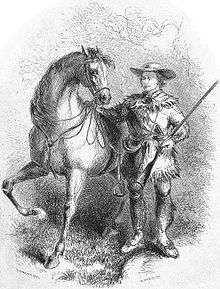
At the age of nineteen, Carson began his career as a mountain man. He traveled through many parts of the American West with famous mountain men like Jim Bridger and Old Bill Williams. He spent the winter of 1828–1829 as a cook for Ewing Young in Taos.[13] He joined Young's trapping expedition of 1829. The leadership of Young and the experience of the venture are credited with shaping Carson's early life in the mountains.
During August 1829 the party went into Apache country along the Gila River. The expedition was attacked, being Carson's first experience of combat. Young's party continued on into Alta California trapping and trading in California from Sacramento in the north to Los Angeles in the south, returning to Taos, New Mexico in April 1830 after trapping along the Colorado River.[14]
Carson joined a wagon train rescue party after entering Taos, and although the perpetrators had fled the scene of atrocities Young had the opportunity to witness Carson's horsemanship and courage. Carson joined another expedition led by Thomas Fitzpatrick and William Levin in 1831. Fitzpatrick, Levin and his trappers went north to the central Rocky Mountains. Carson would hunt and trap in the West for about ten years. He was known as a reliable man and a good fighter.[15]
Life for Carson as a mountain man was not easy. After collecting beavers from traps, he had to hold onto them for months at a time until the annual Rocky Mountain Rendezvous,[16] held in remote areas of the West like the banks of the Green River in Wyoming. With the money received for the pelts, necessities of an independent life including fish hooks, flour and tobacco were procured. As there was little to no medical access in the varied regions he worked in, Carson had to dress his wounds and nurse himself.[17] Conflict with particular Indians sometimes occurred.[18] Carson's primary clothing at the time was in deer skins that had stiffened after being left outdoors for a time. This suit offered some protection against particular weapons employed by Indians.[19]
Grizzly bears were one of the mountain man's greatest enemies.[20] A particular incident involving the animals happened to Carson in 1834 as he was hunting an elk alone. Two bears crossed paths with him and quickly chased him up a tree. One of the bears tried to make him fall by shaking the tree, but was not successful and eventually went away. Carson returned to his camp as fast as he could. He wrote in his Memoirs that: "[The bear] finally concluded to leave, of which I was heartily pleased, never having been so scared in my life."[21]
The last rendezvous was held in 1840.[22] At that time, the fur trade began to drop off. Fashionable men in London, Paris, and New York wanted silk hats instead of beaver hats. In addition, beaver populations across North America were declining rapidly from over-exploitation. Carson knew it was time to find other work. He wrote in his Memoirs that "Beaver was getting scarce, it became necessary to try our hand at something else."
In 1841, he was hired at Bent's Fort in Colorado. This fort was one of the greatest buildings in the West. Hundreds of people worked or lived there. Carson hunted buffalo, antelope, deer, and other animals to feed these people. He was paid one dollar a day. He returned to Bent's Fort several times during his life to again provide meat for the fort's residents.[23]
Indian fighter
Carson was nineteen when he set off with Ewing Young's expedition to the Rocky Mountains in 1829. In addition to furs and the company of free-spirited, rugged mountain men, Carson sought action and adventure. He found what he was looking for in killing and scalping Indians. Carson probably killed and took the scalp of his first Indian when he was nineteen years old, during Ewing Young's expedition.[24]
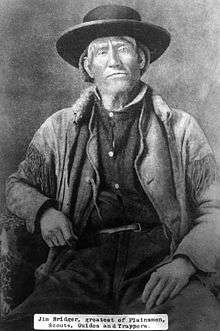
Carson's Memoirs are replete with stories about hostile Indian encounters with the memoirist. In January 1833, for example, warriors of the Crow tribe stole nine horses from Carson's camp. Carson and two other men sprayed the Crow camp with gunfire, killing almost every Crow. Carson wrote in his Memoirs: "During our pursuit for the lost animals, we suffered considerably but, the success of having recovered our horses and sending many a redskin to his long home, our sufferings were soon forgotten."[25]
Carson viewed the Blackfoot nation as a hostile tribe, believing they posed the greatest threat to his livelihood, safety, and life. He hated the Blackfeet, and killed them at every opportunity. Historian David Roberts has written: "It was taken for granted that the Blackfeet were bad Indians; to shoot them whenever he could was a mountain man's instinct and duty."[26]
Carson had several encounters with the Blackfeet. His last battle with the Blackfeet took place in spring 1838. He was traveling with about one hundred mountain men led by Jim Bridger. In Montana territory, the group found a teepee with three Indian corpses inside. These three had died of smallpox. Bridger wanted to move on, but Carson and the other young men wanted to kill the Blackfeet.[27]
They found the Blackfoot village, and killed ten Blackfeet warriors. The Blackfeet found some safety in a pile of rocks, but were driven away. It is not known how many Blackfeet died in this incident. Historian David Roberts writes: "[I]f anything like pity filled Carson's breast as, in his twenty-ninth year, he beheld the ravaged camp of the Blackfeet, he did not bother to remember it." Carson wrote in his Memoirs that this battle was "the prettiest fight I ever saw."[27]
Carson's notions about Indians softened over the years. He found himself more and more in their company as he grew older. His notions about Indians became more understanding and more humane. He urged the government to set aside lands called reservations for their use. As an Indian agent, he saw to it that those under his watch were treated with honesty, fairness, and clothed and fed properly. Historian David Roberts believes his first marriage to an Arapaho woman named Singing Grass "softened the stern and pragmatic mountaineer's opportunism."[21]
Expeditions with John Charles Frémont (1842–1848)

In April 1842, Carson went back to his childhood home in Missouri to put his daughter Adaline in the care of relatives.[23] On the return trip, Carson met John C. Frémont aboard a steamboat on the Missouri River. Frémont was a United States Army officer in the Corps of Topographical Engineers. He was about to lead an expedition into the West. After a brief conversation, Frémont hired Carson as a guide at $100 a month. It was the best-paying job of Carson's life.[28] Frémont wrote, "I was pleased with him and his manner of address at this first meeting. He was a man of medium height, broad-shouldered, and deep-chested, with a clear steady blue eye and frank speech and address; quiet and unassuming."[29]
First expedition, 1842
In 1842, Carson guided Frémont across the Oregon Trail to South Pass, Wyoming. This was their first expedition into the West together. The purpose of this expedition was to map and describe the Oregon Trail as far as South Pass. A guidebook, maps, and other paraphernalia would be printed for westward-bound migrants and settlers. After the five-month, trouble-free mission was accomplished, Frémont wrote his government reports. These reports made Carson's name known across the United States, and spurred a migration of settlers westward to Oregon via the Oregon Trail.[30]
Second expedition, 1843
In 1843, Frémont asked Carson to join his second expedition. Carson did. He guided Frémont across part of the Oregon Trail to the Columbia River in Oregon. The purpose of the expedition was to map and describe the Oregon Trail from South Pass, Wyoming to the Columbia River. They also side-tripped to Great Salt Lake in Utah, using rubber rafts to navigate the waters.[31] On the way to California, the party suffered from bad weather in the Sierra Nevada Mountains, but were saved by Carson's good judgement and his skills as a guide. They found American settlers who fed them. The expedition then headed to California. This was illegal and dangerous because California was Mexican territory. The Mexican government ordered Frémont to leave. Frémont finally went back to Washington, D.C. The government liked his reports, but ignored his illegal trip into Mexico. Frémont was made a captain. The newspapers nicknamed him "The Pathfinder".[32]
During this expedition, Frémont trekked into the Mojave Desert. His party met a Mexican man and boy. The two told Carson that Native Americans had ambushed their party of travelers. The male travelers were killed; the women travelers were staked to the ground, sexually mutilated, and killed. The murderers then stole the Mexicans' thirty horses. Carson and a mountain man friend named Alexis Godey went after the murderers. They took two days to find them. They rushed into their camp, killing and scalping two of the murderers. The stolen horses were recovered and returned to the Mexican man and boy. This deed brought Carson even greater fame. It confirmed his status as a western hero in the eyes of the American people.[33]
Third expedition, 1845
In 1845, Carson guided Frémont on their third and last expedition. They went to California and Oregon. Frémont made scientific plans, but the expedition appeared to be political in nature. Frémont may have been working under secret government orders. President Polk wanted the province of Alta California for the United States. Once in California, Frémont started to rouse the American settlers into a patriotic fever. The Mexican government ordered him to leave. Frémont went north to Oregon. He camped near Klamath Lake. Messages from Washington, DC made it clear that President Polk wanted California.
At Klamath Lake in southern Oregon, Frémont's party was attacked by about twenty Indians on the night of March 6, 1846. Historians agree that these were most likely Modoc men. Three men in camp were killed. The attackers fled after a brief struggle. Carson was angry that his friends had been killed. He took an axe and avenged the death of his friends by chopping away at a dead Indian's face. Fremont wrote, "He knocked his head to pieces."[34]
In retaliation for the attack, a few days later Frémont's party massacred a village of Klamath people along the Williamson River.[35] The entire village was razed and at least 21 men, women and children were killed. The Klamath are a separate people from the Modoc.
Bear Flag Revolt
In June 1846, Frémont and Carson both participated in a California uprising against Mexico called the Bear Flag Revolt. Mexico ordered all Americans to leave California. They did not want to go, and declared California an independent republic. American settlers in California wanted to be free of the Mexican government. The Americans found courage to oppose Mexico because they had Frémont and his troops behind them. Frémont wrote an oath of allegiance. He and his men were able to give some protection to the Americans. He ordered Carson to execute an old Mexican man named Berresaya and his two adult nephews. These three were captured when they stepped ashore at San Francisco Bay. They were executed to keep them from taking reports to Mexico about the uprising.
Frémont worked hard to win California for the United States. He became its military governor. Carson took military records to the Secretary of War in Washington, DC. Frémont wrote, "This was a service of great trust and honor ... and great danger also." In 1847 and 1848, Carson made two quick trips to Washington, DC with messages and reports. In 1848, he took news of the California Gold Strike to the nation's capitol.
Books and dime novels (1847–1859)
Carson's fame spread throughout the United States with government reports, dime novels, newspaper accounts, and word of mouth. The dime novels celebrated Carson's adventures, but were usually colored with exaggeration. A factual biography was attempted by DeWitt C. Peters in 1859, but has been criticized for inaccuracies and exaggerations. Carson became the hero of juvenile fiction not just in the United States, but also published in French, German, Portuguese, Gujarati, Hindi, Singhalese, Arabic and Japanese.
Dime novels
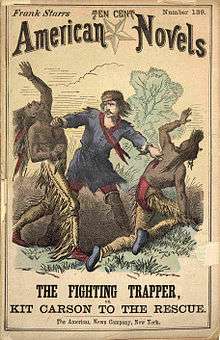
The first story about Carson's adventures was printed in 1847. It was called An Adventure of Kit Carson: A Tale of the Sacramento. It was printed in Holden's Dollar Magazine. Other stories were also printed, such as Kit Carson: The Prince of the Goldhunters and The Prairie Flower. Writers thought Carson the perfect mountain man and Indian fighter. His exciting adventures were printed in the story Kiowa Charley, The White Mustanger; or, Rocky Mountain Kit's Last Scalp Hunt. In this story, an older Kit is said to have "ridden into Sioux camps unattended and alone, had ridden out again, but with the scalps of their greatest warriors at his belt."[36]
Indian captive Mrs. Ann White
In 1849, Carson guided soldiers on the trail of Mrs. Ann White and her baby daughter. They had been captured by Apaches. No one paid attention to Carson's advice about a rescue attempt, and Mrs. White was found dead with an arrow in her heart. She had been horribly abused, and may have been passed among her captors as a camp prostitute. Her child had been carried away, and was never found.
A soldier in the rescue party wrote: "Mrs. White was a frail, delicate, and very beautiful woman, but having undergone such usage as she suffered nothing but a wreck remained; it was literally covered with blows and scratches. Her countenance even after death indicated a hopeless creature. Over her corpse, we swore vengeance upon her persecutors."
Carson discovered a book about himself in the Apache camp. This was the first time that he found himself in print. He was the hero of adventure stories. He was sorry for the rest of his life that Mrs. White had been killed. He wrote in his Memoirs: "In camp was found a book, the first of the kind I had ever seen, in which I was made a great hero, slaying Indians by the hundreds ... I have often thought that Mrs. White read the same ... [and prayed] for my appearance that she might be saved."[37]
Memoirs
In 1856, Carson told his life story to someone who wrote it down. This book is called Memoirs. The manuscript was lost when taken East to find a professional writer who would work it into a book. Washington Irving was asked, but declined. The lost manuscript was found in a trunk in Paris in 1905. It was later printed. The first biography of Carson was written by DeWitt C. Peters in 1859. The book was called Kit Carson, the Nestor of the Mountains, from Facts Narrated by Himself. When the book was read to Carson he said, "Peters laid it on a leetle too thick."[38]
Mexican–American War (1846–1848)
Lasting from 1846 to 1848, the Mexican–American War was an armed conflict between the United States and Mexico. At war's end, Mexico was forced to sell the territories of Alta California and New Mexico to the United States under The Treaty of Guadalupe Hidalgo.
One of Carson's best known adventures took place during this war. In December 1846, Carson was ordered by General Stephen W. Kearny to guide him and his troops from Socorro, New Mexico to San Diego, California. Mexicans soldiers attacked Kearny and his men near the village of San Pasqual, California.
Kearny was outnumbered. He knew he could not win; he ordered his men to take cover on a small hill. On the night of December 8, Carson, a naval lieutenant named Beale, and an Indian scout left Kearny to bring reinforcements from San Diego, 25 miles (40 km) away. Carson and the lieutenant removed their shoes because they made too much noise, and walked barefoot through the desert. Carson wrote in his Memoirs: "Finally got through, but had the misfortune to lose our shoes. Had to travel over a country covered with prickly pear and rocks, barefoot."[39]
By December 10, Kearny believed reinforcements would not arrive. He planned to break through the Mexican lines the next morning, but 200 mounted American soldiers arrived in San Pasqual late that night. They swept the area, driving the Mexicans away. Kearny was in San Diego on December 12.[40]
Military career (1861–1868)
In April 1861, the American Civil War broke out. Carson left his job as an Indian agent, and joined the Union Army as a lieutenant. He led the 1st New Mexico Volunteer Infantry and trained the new men. In October 1861, he was made a colonel. The Volunteers fought the Confederate forces at Valverde, New Mexico in February 1862. The Confederates won this battle, but were later defeated.
Campaign against the Apaches

Once the Confederates were driven from New Mexico, Carson's commander Major James Henry Carleton turned his attention to the Native Americans. Author and historian Edwin Sabin writes that this officer had a "psychopathic hatred of the Apaches".[41] Carleton led his forces deep into the Mescalero Apache territory. The Mescaleros were tired of fighting, and put themselves under Carson's protection. Carleton put these Apaches on a remote and lonely reservation on the Pecos River.[42]
Carson disliked the Apaches. He wrote in a report that the Jicarilla Apaches "were truly the most degraded and troublesome Indians we have in our department ... [W]e daily witness them in a state of intoxication in our plaza."[43] Carson half-heartedly supported Carleton's plans. He was tired. He had suffered an injury two years before that gave him great trouble. He resigned from the Army in February 1863. Carleton refused to accept the resignation because he wanted Carson to lead a campaign against the Navajo.[43]
Campaign against the Navajo
Carleton had chosen a bleak site on the Pecos River for his reservation. This reservation was called Bosque Redondo (Round Grove). He chose this site for the Apaches and Navajos because it was far from white settlements. He also wanted these Apaches and Navajo to act as a buffer for any aggressive acts committed upon the white settlements from Kiowas and Comanches to the east of Bosque Redondo. He thought as well that the remoteness and desolation of the reservation would discourage white settlement.[44]
The Mescalero Apaches walked 130 miles (210 km) to the reservation. By March 1863, four hundred Apaches had settled around nearby Fort Sumner. Others had fled west to join fugitive bands of Apaches. By middle summer, many of these people were planting crops and doing other farm work.
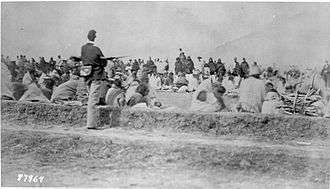
On July 7, Carson, with little heart for the Navajo roundup, started the campaign against the tribe. His orders were almost the same as those for the Apache roundup: he was to shoot all males on sight, and take the women and children captives. No peace treaties were to be made until all the Navajo were on the reservation.[45]
Carson searched far and wide for the Navajo. He found their homes, fields, animals, and orchards, but the Navajo were experts at disappearing quickly and hiding in their vast lands. The roundup proved frustrating for Carson. He was in his 50s, tired, and ill. By autumn 1863, Carson started to burn the Navajo homes and fields, and remove their animals from the area. The Navajo would starve if this destruction continued. One hundred eighty-eight Navajo surrendered. They were sent to Bosque Redondo. Life at the Bosque had turned grim. Murders occurred. The Apaches and Navajos fought. The water in the Pecos contained minerals that gave people cramps and stomach aches. Residents had to walk 12 miles (19 km) to find firewood.[46]
Canyon de Chelly
Carson wanted to take a winter break from the campaign. Major Carleton refused. Kit was ordered to invade the Canyon de Chelly. It was here that many Navajos had taken refuge. Historian David Roberts writes, "Carson's sweep through the Canyon de Chelly in the winter of 1863–1864 would prove to be the decisive action in the Campaign."[47]
The Canyon de Chelly was a sacred place for the Navajo. They believed that it would now be their strongest sanctuary. Three hundred Navajo took refuge on the canyon rim at a place called Fortress Rock. They resisted Carson's invasion by building rope ladders and bridges, lowering water pots into a stream, and keeping quiet and out of sight. These three hundred Navajo survived the invasion. In January 1864, Carson swept through the 35-mile (56 km) Canyon with his forces. The thousands of peach trees in the canyon were cut down. Few Navajo were killed or captured. Carson's invasion, however, proved to the Navajo that the United States could invade their country at any time. Many Navajo surrendered at Fort Canby.[48]
By March 1864, there were 3,000 refugees at Fort Canby. An additional 5,000 arrived in the camp. They were suffering from the intense cold and hunger. Carson asked for supplies to feed and clothe them. The thousands of Navajo were led to Bosque Redondo. Many died along the way. Stragglers in the rear were shot and killed. In Navajo history, this horrific trek is known as Long Walk of the Navajo. By 1866, reports indicated that Bosque Redondo was a complete failure. Major Carleton was fired. Congress started investigations. In 1868, a treaty was signed, and the Navajo were allowed to return to their homeland. Bosque Redondo was closed.[49]
First Battle of Adobe Walls
On November 25, 1864, Carson led his forces against the southwestern tribes at the First Battle of Adobe Walls in the Texas panhandle. Adobe Walls was an abandoned trading post blown up by its inhabitants to prevent a take-over by hostile Indians. Combatants at the First Battle were the United States Army and Indian scouts against Kiowas, Comanches, and Plains Apaches. It was one of the largest engagements fought on the Great Plains.
The battle was the result of General Carleton's belief that Indians were responsible for the continuing attacks on settlers along the Santa Fe Trail. He wanted to punish them and brought in Carson to do the job. With most of the Army engaged elsewhere during the American Civil War, the protection the settlers sought was almost nonexistent. Carson led 260 cavalry, 75 infantry, and 72 Ute and Jicarilla Apache Army scouts. In addition, he had two mountain howitzer cannons.[50]
"Throw a few shells into that crowd over there."
Kit Carson to artillery officer Lt. Pettis[51]
On the morning of November 25, Carson discovered and attacked a Kiowa village of 176 lodges. After destroying this village, he moved forward to Adobe Walls. Carson found other Comanche villages in the area, and realized he would face a very large force of Native Americans. A Captain Pettis estimated that 1,200 to 1,400 Comanche and Kiowa began to assemble. The number would swell to possibly 3,000. Four to five hours of battle ensued. When Carson ran low on ammunition and howitzer shells, he ordered his men to retreat to a nearby Kiowa village. There they burned the village and many fine buffalo robes. His Indian scouts killed and mutilated four elderly and weak Kiowas.[50]
The retreat to New Mexico was then begun. There were few deaths among Carson's men. General Carleton wrote to Carson: "This brilliant affair adds another green leaf to the laurel wreath which you have so nobly won in the service of your country." [50]
Personal life
Personal description
In 1847, General William Tecumseh Sherman met Kit Carson in Monterey, California. Sherman wrote: "His fame was then at its height, ... and I was very anxious to see a man who had achieved such feats of daring among the wild animals of the Rocky Mountains, and still wilder Indians of the plains ... I cannot express my surprise at beholding such a small, stoop-shouldered man, with reddish hair, freckled face, soft blue eyes, and nothing to indicate extraordinary courage or daring. He spoke but little and answered questions in monosyllables."
Colonel Edward W. Wynkoop wrote: "Kit Carson was five feet five and one half-inches tall, weighed about 140 pounds, of nervy, iron temperament, squarely built, slightly bow-legged, and those members apparently too short for his body. But, his head and face made up for all the imperfections of the rest of his person. His head was large and well-shaped with yellow straight hair, worn long, falling on his shoulders. His face was fair and smooth as a woman's with high cheekbones, straight nose, a mouth with a firm, but somewhat sad expression, a keen, deep-set but beautiful, mild blue eye, which could become terrible under some circumstances, and like the warning of the rattlesnake, gave notice of attack. Though quick-sighted, he was slow and soft of speech, and posed great natural modesty.
Lieutenant George Douglas Brewerton made one coast-to-coast dispatch-carrying trip to Washington, D.C. with Carson. Brewerton wrote: "The Kit Carson of my imagination was over six feet high — a sort of modern Hercules in his build — with an enormous beard, and a voice like a roused lion ... The real Kit Carson I found to be a plain, simple ... man; rather below the medium height, with brown, curling hair, little or no beard, and a voice as soft and gentle as a woman's. In fact, the hero of a hundred desperate encounters, whose life had been mostly spent amid wilderness, where the white man is almost unknown, was one of Dame Nature's gentleman ..."[52]
Marriages
Carson was married three times. His first two wives were Native American. His third wife was Mexican. Carson was the father of ten children. He never wrote about his first two marriages in his Memoirs. He may have thought he would be known as a "squaw man". Such men were not welcomed by polite society.[53]
In 1836, Carson met an Arapaho woman named Waanibe (Singing Grass, or Grass Singing) at a mountain man rendezvous held along the Green River in Wyoming. Singing Grass was a lovely young woman, and many mountain men were in love with her.[54] Carson was forced to fight a duel with a French trapper named Chouinard for Waanibe's hand in marriage. Carson won, but he had a very narrow escape. The French trapper's bullet singed his hair. The duel was one of the best known stories about Carson in the 19th century.[55]
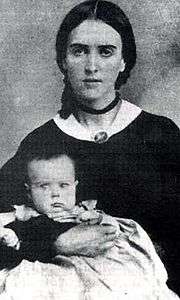
Carson married Singing Grass. She tended to his needs, and went with him on his trapping trips. They had a daughter named Adaline (or Adeline). Singing Grass died after giving birth to Carson's second daughter. This child did not live long. In 1843, she fell into a kettle of boiling soap in Taos, New Mexico. Waanibe died about 1841.[56]
Carson's life as a mountain man was too hard for a little girl so he took Adaline to live with his sister Mary Ann Carson Rubey in Saint Louis, Missouri. Adaline was taught in a school for girls called a seminary. Carson brought her West when she was a teenager. She married a George Stilts of Saint Louis, and divorced. In 1858, she went to the California goldfields. Adaline died in 1860[57] or after 1862. Probably in Mono County, California[58]
In 1841, Carson married a Cheyenne woman named Making-Out-Road. They were together only a short time. Making-Out-Road divorced him in the way of her people by putting Adaline and all of Carson's property outside their tent. Making-Out-Road left Carson to travel with her people through the west.
About 1842, Carson met Josefa Jaramillo. She was the daughter of a wealthy and prominent Mexican couple living in Taos. Carson wanted to marry her. He left the Presbyterian Church for the Catholic Church, and married 14-year-old Josefa on February 6, 1843. They had eight children.
Illiteracy
Carson was illiterate. He was embarrassed by this, and tried to hide it.[59] In 1856, he dictated his Memoirs to another and stated then: "I was a young boy in the school house when the cry came, Injuns! I jumped to my rifle and threw down my spelling book, and thar it lies."
Carson enjoyed having other people read to him, and preferred the poetry of George Gordon, Lord Byron. Carson thought Sir Walter Scott's long poem, The Lady of the Lake was "the finest expression of outdoor life."[60] Carson eventually learned to write "C. Carson", but it was very difficult for him. He made his mark on official papers, and this mark was then witnessed by a clerk or other official.[61]
Death
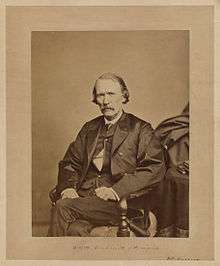
When the Civil War ended, and the Indian Wars campaigns were in a lull, Carson was breveted a General and appointed commandant of Ft. Garland, Colorado, in the heart of Ute country. Carson had many Ute friends in the area and assisted in government relations.
After being mustered out of the Army, Carson took up ranching, settling at Boggsville in Bent County. In 1868, at the urging of Washington and the Commissioner of Indian Affairs, Carson journeyed to Washington D.C. where he escorted several Ute Chiefs to meet with the President of the United States to plead for assistance to their tribe.
Soon after his return, his wife Josefa died from complications after giving birth to their eighth child. Her death was a crushing blow to Carson. He died a month later at age 58 on May 23, 1868, in the presence of Dr. Tilton and his friend Thomas Boggs. His last words were "Goodbye, friends. Adios, compadres". Carson died from an abdominal aortic aneurysm in the surgeon's quarters of Fort Lyon, Colorado. His resting place is Taos, New Mexico.
Legacy
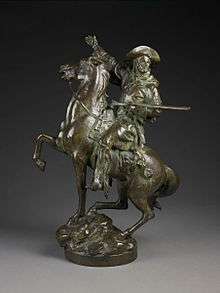
Carson's home in Taos, New Mexico is today a museum called the Kit Carson Home and Museum. A monument was raised in the plaza at Santa Fe by the New Mexico Grand Army. In Denver, a statue of a mounted Kit Carson can be found atop the Mac Monnies Pioneer Monument. Another equestrian statue can be seen in Trindad. A national forest in New Mexico was named for Carson as well as a county in Colorado. A river in Nevada is named for Carson as well as the state's capital, Carson City. Fort Carson, an army training post near Colorado Springs, was named for him during World War II by popular vote of the men training there.[62]
Carson has been widely depicted in film and television series. In 1966, the actor Phillip Pine played Carson with Michael Pate as fellow Fremont scout Frenchy Godey in the episode "Samaritans, Mountain Style" of the syndicated series, Death Valley Days, hosted by Robert Taylor. In the story line, Carson and Godey stop to help a settler in dire straits.
In the 1960s and 1970s, Carson came under the scrutiny of revisionist historians and ideas regarding his historical legacy began to change. Earlier accounts portrayed Carson as an American hero, but in scholarship of this period he became an arch-villain in the military campaigns against the Indians. In 1992, for example, a young professor at Colorado College was successful in demanding that a period photograph of Carson be removed from the ROTC office. In 1992, a tourist told a journalist at the Carson home in Taos, "I will not go into the home of that racist, genocidal killer." In the 1970s, a Navajo at a trading post said, "No one here will talk about Kit Carson. He was a butcher." In 1993, a symposium was organized to air various views on Carson, but the Navajo spokespeople refused to attend.[63]
Over time, historical analysis of Carson shifted again. David Roberts writes, "Carson's trajectory, over three and a half decades, from thoughtless killer of Apaches and Blackfeet to defender and champion of the Utes, marks him out as one of the few frontiersmen whose change of heart toward the Indians, born not of missionary theory but of first hand experience, can serve as an exemplar for the more enlightened policies that sporadically gained the day in the twentieth century."[64]
Reputation

Carson's contributions to western history have been reexamined by historians, journalists and Indian activists since the 1960s. In 1968, Carson biographer Harvey L. Carter stated:
In respect to his actual exploits and his actual character, however, Carson was not overrated. If history has to single out one person from among the Mountain Men to receive the admiration of later generations, Carson is the best choice. He had far more of the good qualities and fewer of the bad qualities than anyone else in that varied lot of individuals.[65]
Some journalists and authors during the last 25 years presented an alternative view of Kit Carson. For instance, Virginia Hopkins stated in 1988 that "Kit Carson was directly or indirectly responsible for the deaths of thousands of Indians".[66]
Sides said that Carson believed the Native Americans needed reservations as a way of physically separating and shielding them from white hostility and white culture. He is said to have viewed the raids on white settlements as driven by desperation, "committed from absolute necessity when in a starving condition." Indian hunting grounds were disappearing as waves of white settlers filled the region.[67]
In 2014 there was a petition to rename Kit Carson Park in Taos, NM Red Willow Park. Despite the support of the Taos Pueblo and the residents of Taos Valley the park was not renamed and still bears the Kit Carson moniker.[68]
See also
Notes
- 1 2 3 4 Roberts 54–55
- ↑ Guild and Carter 3
- 1 2 3 Sides 8–9
- ↑ Guild and Carter 9
- ↑ Guild and Carter 10
- ↑ Guild and Carter 15
- ↑ Carter 38–39
- ↑ Guild and Carter 27
- 1 2 3 Roberts 56–57
- ↑ Carter 42–50.
- ↑ Sides 14
- ↑ Guild and Carter 26
- ↑ Guild and Carter 32
- ↑ Carter 42–50
- ↑ Guild and Carter 48
- ↑ Sides 15
- ↑ Cleland 44
- ↑ Cleland 40–41
- ↑ Cleland 21
- ↑ Cleland 43
- 1 2 Roberts 80
- ↑ Sides 33–34
- 1 2 Roberts 99–101
- ↑ Sides 16
- ↑ Roberts 82
- ↑ Roberts 85
- 1 2 Roberts 87–88
- ↑ Roberts 123
- ↑ Roberts 102–103
- ↑ Sides 50–53
- ↑ Roberts 130
- ↑ Sides 59–61
- ↑ Sides 62–64
- ↑ Sides 78–81
- ↑ Amy Couture. Captain John C. Fremont Clashes With Klamath Indians, Jefferson Public Radio, 2011.
- ↑ Roberts 52, 79
- ↑ Sides 258–259
- ↑ Roberts 253–254
- ↑ Sides 163
- ↑ Sides 164–165
- ↑ Roberts 255
- ↑ Roberts 257
- 1 2 Roberts 258
- ↑ Roberts 259
- ↑ Roberts 260
- ↑ Roberts 262
- ↑ Roberts 263
- ↑ Roberts 265–269
- ↑ Roberts 270–281
- 1 2 3 Guild 255
- ↑ "Fort Tours – Adobe Walls". forttours.com.
- ↑ Roberts 187
- ↑ Roberts 71
- ↑ Sides pp. 29–30.
- ↑ Roberts 70
- ↑ Roberts 98
- ↑ Roberts 101–102
- ↑ Marc Simmons (2003). Kit Carson & His Three Wives: A Family History. UNM Press.
- ↑ Sides 50–51
- ↑ Roberts 186
- ↑ Roberts 55
- ↑ Guild 283–284
- ↑ Roberts 292–295
- ↑ Roberts 294
- ↑ Carter 210
- ↑ Hopkins 40
- ↑ Sides 334
- ↑ jrobertson (July 3, 2014). "Not So Fast: Kit Carson Park in Taos, NM, Might NOT Be Renamed". Indian Country Today Media Network.com. Retrieved October 7, 2016.
References
- Carter, Harvey Lewis. "Dear Old Kit": The Historical Christopher Carson, Norman: University of Oklahoma Press (August 1990), ISBN 978-0-8061-2253-3
- Cleland, Robert Glass (1950). This Reckless Breed of Men: The Trappers and Fur Traders of the Southwest. New York City: Knopf.
- Guild, Thelma S. and Harvey L. Carter (1988), Kit Carson: A Pattern for Heroes. University of Nebraska Press ISBN 0-8032-7027-5
- Hopkins, Virginia, Pioneers of the Old West, New York, NY: Crown Publishers, Inc., 1988. ISBN 0-517-64930-6.
- "Kit Carson: The Legendary Frontiersman Remains an American Hero"
- Roberts, David (2001), A newer world: Kit Carson, John C. Fremont and the claiming of the American west, New York: Touchstone ISBN 0-684-83482-0.
- Sides, Hampton, Blood and Thunder, Doubleday, 2006. ISBN 0-385-50777-1
Further reading
- Story of the Wild West and Camp-Fire Chats by Buffalo Bill (Hon. W.F. Cody.) "A Full and Complete History of the Renowned Pioneer Quartette, Boone, Crockett, Carson and Buffalo Bill.", c1888 by HS Smith, published 1889 by Standard Publishing Co., Philadelphia, PA.
External links
| Wikiquote has quotations related to: Kit Carson |
- Guide to the Kit Carson Papers at The Bancroft Library
- Kit Carson Papers – Missouri History Museum
- Narrative of the Exploring Expedition to the Rocky Mountains By John Charles Frémont. Published 1845.
- New York Times book review of Blood and Thunder
- The Daring Adventures of Kit Carson and Fremont, Among Buffaloes, Grizzlies. By John Charles Frémont. Published 1888.
- The First, and a Little-known, 1847 Biography of Kit Carson
- The Life and Adventures of Kit Carson, the Nestor of the Rocky Mountains, from Facts Narrated by Himself (1858) by De Witt C. Peters, at Project Gutenberg and at Google Books.
-
 "Carson, Christopher". Encyclopædia Britannica (11th ed.). 1911.
"Carson, Christopher". Encyclopædia Britannica (11th ed.). 1911. -
 "Carson, Christopher". Appletons' Cyclopædia of American Biography. 1900.
"Carson, Christopher". Appletons' Cyclopædia of American Biography. 1900. -
 "Carson, Christopher". New International Encyclopedia. 1905.
"Carson, Christopher". New International Encyclopedia. 1905. - Works by The Life of Kit Carson by Edward S. Ellis (1840–1916) at LibriVox (public domain audiobooks)

- 'A West Won by Blood & Thunder' NPR (2006).